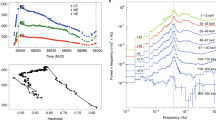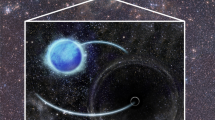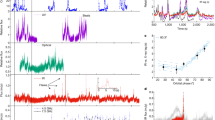Abstract
M82 X-1, the brightest X-ray source in the galaxy M82, has been thought to be an intermediate-mass black hole (100 to 10,000 solar masses) because of its extremely high luminosity and variability characteristics1,2,3,4,5,6, although some models suggest that its mass may be only about 20 solar masses3,7. The previous mass estimates were based on scaling relations that use low-frequency characteristic timescales which have large intrinsic uncertainties8,9. For stellar-mass black holes, we know that the high-frequency quasi-periodic oscillations (100–450 hertz) in the X-ray emission that occur in a 3:2 frequency ratio are stable and scale in frequency inversely with black hole mass with a reasonably small dispersion10,11,12,13,14,15. The discovery of such stable oscillations thus potentially offers an alternative and less ambiguous means of mass determination for intermediate-mass black holes, but has hitherto not been realized. Here we report stable, twin-peak (3:2 frequency ratio) X-ray quasi-periodic oscillations from M82 X-1 at frequencies of 3.32 ± 0.06 hertz and 5.07 ± 0.06 hertz. Assuming that we can extrapolate the inverse-mass scaling that holds for stellar-mass black holes, we estimate the black hole mass of M82 X-1 to be 428 ± 105 solar masses. In addition, we can estimate the mass using the relativistic precession model, from which we get a value of 415 ± 63 solar masses.
This is a preview of subscription content, access via your institution
Access options
Subscribe to this journal
Receive 51 print issues and online access
$199.00 per year
only $3.90 per issue
Buy this article
- Purchase on Springer Link
- Instant access to full article PDF
Prices may be subject to local taxes which are calculated during checkout


Similar content being viewed by others
References
Casella, P. et al. Weighing the black holes in ultraluminous X-ray sources through timing. Mon. Not. R. Astron. Soc. 387, 1707–1711 (2008)
Dewangan, G. C., Titarchuk, L. & Griffiths, R. E. Black hole mass of the ultraluminous X-ray source M82 X-1. Astrophys. J. 637, L21–L24 (2006)
Feng, H. & Kaaret, P. Identification of the X-ray thermal dominant state in an ultraluminous X-ray source in M82. Astrophys. J. 712, L169–L173 (2010)
Mucciarelli, P., Casella, P., Belloni, T., Zampieri, L. & Ranalli, P. A variable quasi-periodic oscillation in M82 X-1. Timing and spectral analysis of XMM-Newton and RossiXTE observations. Mon. Not. R. Astron. Soc. 365, 1123–1130 (2006)
Patruno, A., Portegies Zwart, S., Dewi, J. & Hopman, C. The ultraluminous X-ray source in M82: an intermediate-mass black hole with a giant companion. Mon. Not. R. Astron. Soc. 370, L6–L9 (2006)
Zhou, X.-L., Zhang, S.-N., Wang, D.-X. & Zhu, L. Calibrating the correlation between black hole mass and X-ray variability amplitude: X-ray only black hole mass estimates for active galactic nuclei and ultra-luminous X-ray sources. Astrophys. J. 710, 16–23 (2010)
Okajima, T., Ebisawa, K. & Kawaguchi, T. A stellar-mass black hole in the ultraluminous X-ray source M82 X-1? Astrophys. J. 652, L105–L108 (2006)
Middleton, M. J., Roberts, T. P., Done, C. & Jackson, F. E. Challenging times: a re-analysis of NGC 5408 X-1. Mon. Not. R. Astron. Soc. 411, 644–652 (2011)
Pasham, D. R. & Strohmayer, T. E. On the nature of the mHz X-ray quasi-periodic oscillations from ultraluminous X-ray source M82 X-1: Search for timing-spectral correlations. Astrophys. J. 771, 101 (2013)
McClintock, J. E. & Remillard, R. A. in Compact Stellar X-Ray Sources (eds Lewin, W. & van der Klis, M. ) 157–213 (Cambridge Univ. Press, 2006)
Remillard, R. A., Morgan, E. H., McClintock, J. E., Bailyn, C. D. & Orosz, J. A. RXTE observations of 0.1–300 HZ quasi-periodic oscillations in the microquasar GRO J1655–40. Astrophys. J. 522, 397–412 (1999)
Remillard, R. A., Muno, M. P., McClintock, J. E. & Orosz, J. A. Evidence for harmonic relationships in the high-frequency quasi-periodic oscillations of XTE J1550–564 and GRO J1655–40. Astrophys. J. 580, 1030–1042 (2002)
Remillard, R. A., Sobczak, G. J., Muno, M. P. & McClintock, J. E. Characterizing the quasi-periodic oscillation behavior of the X-ray nova XTE J1550–564. Astrophys. J. 564, 962–973 (2002)
Strohmayer, T. E. Discovery of a 450 HZ quasi-periodic oscillation from the microquasar GRO J1655–40 with the Rossi X-Ray Timing Explorer. Astrophys. J. 552, L49–L53 (2001)
Strohmayer, T. E. Discovery of a second high-frequency quasi-periodic oscillation from the microquasar GRS 1915+105. Astrophys. J. 554, L169–L172 (2001)
Abramowicz, M. A., Kluźniak, W., McClintock, J. E. & Remillard, R. A. The importance of discovering a 3:2 twin-peak quasi-periodic oscillation in an ultraluminous X-ray source, or how to solve the puzzle of intermediate-mass black holes. Astrophys. J. 609, L63–L65 (2004)
Abramowicz, M. A. & Kluźniak, W. Interpreting black hole QPOs. Preprint at http://arxiv.org/abs/astro-ph/0312396 (2003)
Matsumoto, H. et al. Discovery of a luminous, variable, off-center source in the nucleus of M82 with the Chandra High-Resolution Camera. Astrophys. J. 547, L25–L28 (2001)
Stella, L., Vietri, M. & Morsink, S. M. Correlations in the quasi-periodic oscillation frequencies of low-mass X-ray binaries and the relativistic precession model. Astrophys. J. 524, L63–L66 (1999)
Motta, S. E., Belloni, T. M., Stella, L., Munoz-Darias, T. & Fender, R. Precise mass and spin measurements for a stellar-mass black hole through X-ray timing: the case of GRO J1655–40. Mon. Not. R. Astron. Soc. 437, 2554–2565 (2014)
Pasham, D. R. & Strohmayer, T. E. Can the 62 day X-ray period of ULX M82 X-1 be due to a precessing accretion disk? Astrophys. J. 774, L16 (2013)
Kaaret, P. & Feng, H. Confirmation of the 62 day X-ray periodicity from M82. Astrophys. J. 669, 106–108 (2007)
Voss, R., Nielsen, M. T. B., Nelemans, G., Fraser, M. & Smartt, S. J. On the association of ULXs with young superclusters: M82 X-1 and a new candidate in NGC 7479. Mon. Not. R. Astron. Soc. 418, L124 (2011)
Portegies Zwart, S. F., Baumgardt, H., Hut, P., Makino, J. & McMillan, S. L. W. Formation of massive black holes through runaway collisions in dense young star clusters. Nature 428, 724–726 (2004)
Caballero-García, M. D., Belloni, T. & Zampieri, L. Quasi-periodic oscillations and energy spectra from the two brightest ultra-luminous X-ray sources in M82. Mon. Not. R. Astron. Soc. 436, 3262–3270 (2013)
Casella, P., Belloni, T. & Stella, L. The ABC of low-frequency quasi-periodic oscillations in black hole candidates: analogies with Z sources. Astrophys. J. 629, 403–407 (2005)
Belloni, T. M., Sanna, A. & Mèndez, M. High-frequency quasi-periodic oscillations in black hole binaries. Mon. Not. R. Astron. Soc. 426, 1701–1709 (2012)
Beer, M. E. & Podsiadlowski, P. The quiescent light curve and the evolutionary state of GRO J1655–40. Mon. Not. R. Astron. Soc. 331, 351–360 (2002)
Orosz, J. A. et al. An improved dynamical model for the microquasar XTE J1550–564. Astrophys. J. 730, 75–88 (2011)
Steeghs, D. et al. The not-so-massive black hole in the microquasar GRS1915+105. Astrophys. J. 768, 185–192 (2013)
van der Klis, M. in Timing Neutron Stars: Proc. NATO Adv. Study Inst. Timing Neutron Stars (eds Ogelman, H. & van den Heuvel, E. P. J. ) 27 (Kluwer Academic/Plenum, 1989)
Leahy, D. A. et al. On searches for pulsed emission with application to four globular cluster X-ray sources - NGC 1851, 6441, 6624, and 6712. Astrophys. J. 266, 160–170 (1983)
Chiang, Y.-K. & Kong, A. K. H. The long-term variability of the X-ray sources in M82. Mon. Not. R. Astron. Soc. 414, 1329–1338 (2011)
Wood, K. S. et al. USA experiment and RXTE observations of a variable low-frequency quasi-periodic oscillation in XTE J1118+480. Astrophys. J. 544, L45–L48 (2000)
Rodriguez, J., Corbel, S., Kalemci, E., Tomsick, J. A. & Tagger, M. An X-ray timing study of XTE J1550-564: evolution of the low-frequency quasi-periodic oscillations for the complete 2000 outburst. Astrophys. J. 612, 1018–1025 (2004)
Jin, J., Feng, H. & Kaaret, P. Transition to the disk dominant state of a new ultraluminous X-ray source in M82. Astrophys. J. 716, 181–186 (2010)
Feng, H., Rao, F. & Kaaret, P. Discovery of millihertz X-ray oscillations in a transient ultraluminous X-ray source in M82. Astrophys. J. 710, L137–L141 (2010)
Laycock, S. et al. Long-term behavior of X-ray pulsars in the Small Magellanic Cloud. Astrophys. J. 161, 96–117 (2005)
Giles, A. B. et al. The main characteristics of GRO J1744-28 observed by the proportional counter array experiment on the Rossi X-Ray Timing Explorer. Astrophys. J. 469, L25 (1996)
Jahoda, K. et al. Peak luminosities of bursts from GRO J1744-28 measured with the RXTE PCA. Nucl. Phys. B Proc. Suppl. 69, 210–215 (1999)
Sazonov, S. Y., Sunyaev, R. A. & Lund, N. Super-Eddington X-ray luminosity of the bursting pulsar GRO J1744-28: WATCH/Granat observations. Astron. Lett. 23, 286–292 (1997)
Negoro, H. et al. MAXI/GSC and Swift/BAT detection of enhanced hard X-ray emission from the Galactic center region, renewed activity of GRO J1744-28? Astron. Telegr. 5790, (2014)
Finger, M. H. Jenke, P. A. & Wilson-Hodge, C. Fermi/GBM detection of 0.467s pulsation from GRO J1744-28. Astron. Telegr. 5810, (2014)
Kennea, J. A. Kouveliotou, C. & Younes, G. GRO J1744-28: Swift XRT confirmation of outburst. Astron. Telegr. 5845, (2014)
D’Ai, A. et al. GRO J1744-28 active as X-ray pulsar. Astron. Telegr. 5858, (2014)
Linares, M. Kennea, J., Krimm, H. & Kouveliotou, C. Swift detects bursting activity from GRO J1744-28. Astron. Telegr. 5883, (2014)
Pintore, F. et al. Detection of a spin derivative in GRO J1744-28 with Swift/XRT. Astron. Telegr. 5901, (2014)
Kommers, J. M. et al. Postburst quasi-periodic oscillations from GRO J1744-28 and from the rapid burster. Astrophys. J. 482, L53 (1997)
Acknowledgements
This work is based on observations made with the Rossi X-ray Timing Explorer, a mission that was managed and controlled by NASA’s Goddard Space Flight Center in Greenbelt, Maryland, USA. All the data used in the present article is publicly available through NASA’s HEASARC archive. D.R.P. would like to thank M. Trippe, C. Miller and C. Reynolds for discussions.
Author information
Authors and Affiliations
Contributions
D.R.P. and T.E.S. reduced the data, carried out the analysis and wrote the paper. R.F.M. contributed to the interpretation of the results.
Corresponding author
Ethics declarations
Competing interests
The authors declare no competing financial interests.
Extended data figures and tables
Extended Data Figure 1 Sample RXTE/PCA light curves and power density spectra of M82.
The 128 s X-ray (3–13 keV) light curves (a, c) and the corresponding power spectra (b, d) of M82. The corresponding observation IDs are shown in the top right of each panel. The light curves have a bin size of 1 s, and the power spectra have a frequency resolution of 0.125 Hz. The error bars in a and c represent the standard error of the mean.
Extended Data Figure 2 Long-term X-ray (3–13 keV) light curves of three accreting supermassive black holes.
These were extracted from the same time window as the M82 observations (2004 September 2 to 2005 April 30 and 2006 March 3 to 2009 December 30). Data from 3C 111, MKN 110 and 3C 273 are shown in a, b and c, respectively. The count rates are not corrected for background.
Extended Data Figure 3 Average X-ray (3–13 keV) power spectra of three accreting supermassive black holes.
Similar to the M82 analysis, these spectra were extracted by combining all the data (128 s data segments) shown in Extended Data Fig. 2. The Poisson noise level is equal to 2, and the 99.73% and 99.99% confidence contours are indicated by horizontal dotted lines. The two dashed vertical lines are drawn at 3.32 and 5.07 Hz. In all three cases, 3C 111 (a), MKN 110 (b) and 3C 273 (c), there are no significant power spectral features. The total PCA exposures used for these spectra were 630 ks (a), 738 ks (b) and 711 ks (c).
Extended Data Figure 4 Long-term X-ray light curve and the average power density spectrum of a background sky field of RXTE/PCA.
Similar to Extended Data Fig. 3, the 99.73% and 99.99% contours and the vertical lines at 3.32 and 5.07 Hz are indicated in the power density spectrum (b). Again, only observations coincident with M82 monitoring were used (2004 September 2 to 2005 April 30 and 2006 March 3 to 2009 December 30), and the total exposure time was 1,450 ks. The light curve (3–13 keV) is shown in (a). The background has coordinates of RA = 5.0°, dec. = −67.0°.
Supplementary information
Dynamic power density spectrum 1
Dynamic power density spectrum of M82 X1 using 128-second light curves. As the video frames progress more data is being added which decreases the overall noise level. The two horizontal lines show the 99.73% and 99.99% confidence levels. The two statistically significant features are at 3.32 Hz and 5.07 Hz consistent with a 3:2 frequency ratio. (MP4 4165 kb)
Dynamic power density spectrum 2
Same as Supplementary Video 1 but instead we used 1024-second light curves (see Methods for details). (MP4 3299 kb)
PowerPoint slides
Rights and permissions
About this article
Cite this article
Pasham, D., Strohmayer, T. & Mushotzky, R. A 400-solar-mass black hole in the galaxy M82. Nature 513, 74–76 (2014). https://doi.org/10.1038/nature13710
Received:
Accepted:
Published:
Issue Date:
DOI: https://doi.org/10.1038/nature13710
This article is cited by
-
Study of the ultraluminous X-ray sources in NGC 4382 and NGC 1399 with Chandra
Indian Journal of Physics (2024)
-
Study of accretion flows around an ultraluminous X-ray source M82 X-1 using NuSTAR data
Journal of Astrophysics and Astronomy (2022)
-
Is the binding energy of galaxies related to their core black hole mass?
Journal of Astrophysics and Astronomy (2021)
-
Detectability of intermediate-mass black holes in multiband gravitational wave astronomy
Nature Astronomy (2019)
Comments
By submitting a comment you agree to abide by our Terms and Community Guidelines. If you find something abusive or that does not comply with our terms or guidelines please flag it as inappropriate.



